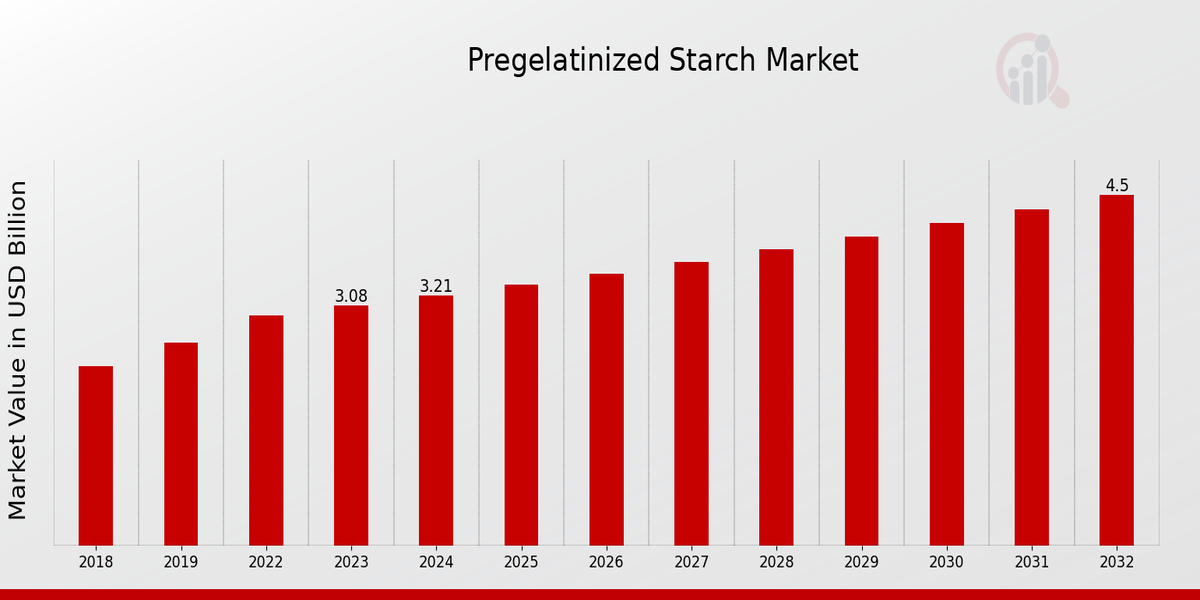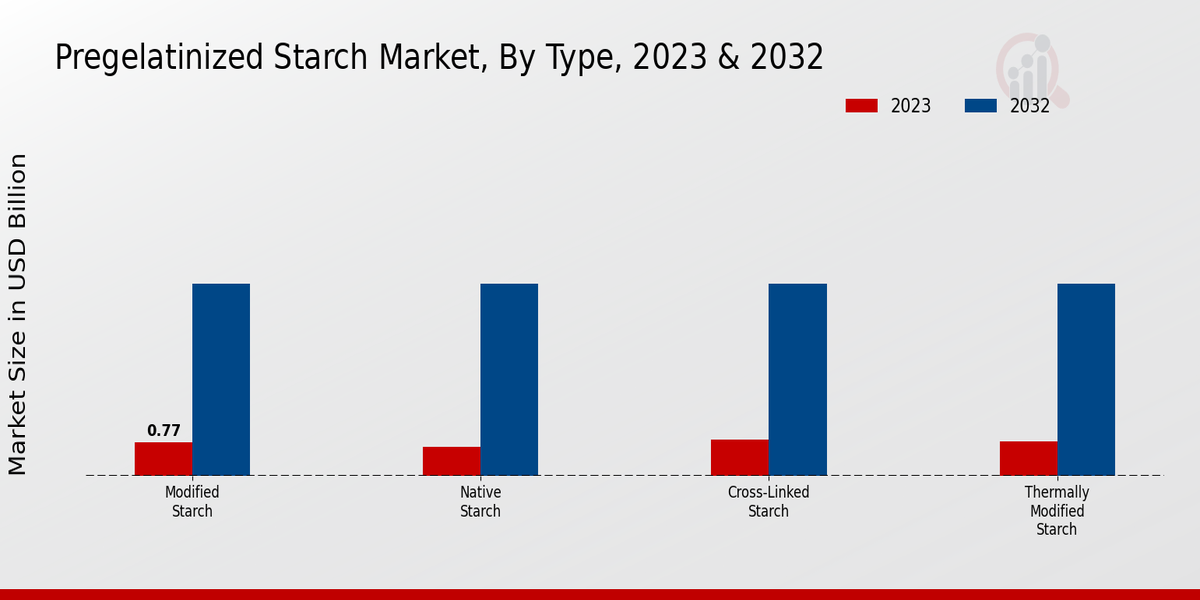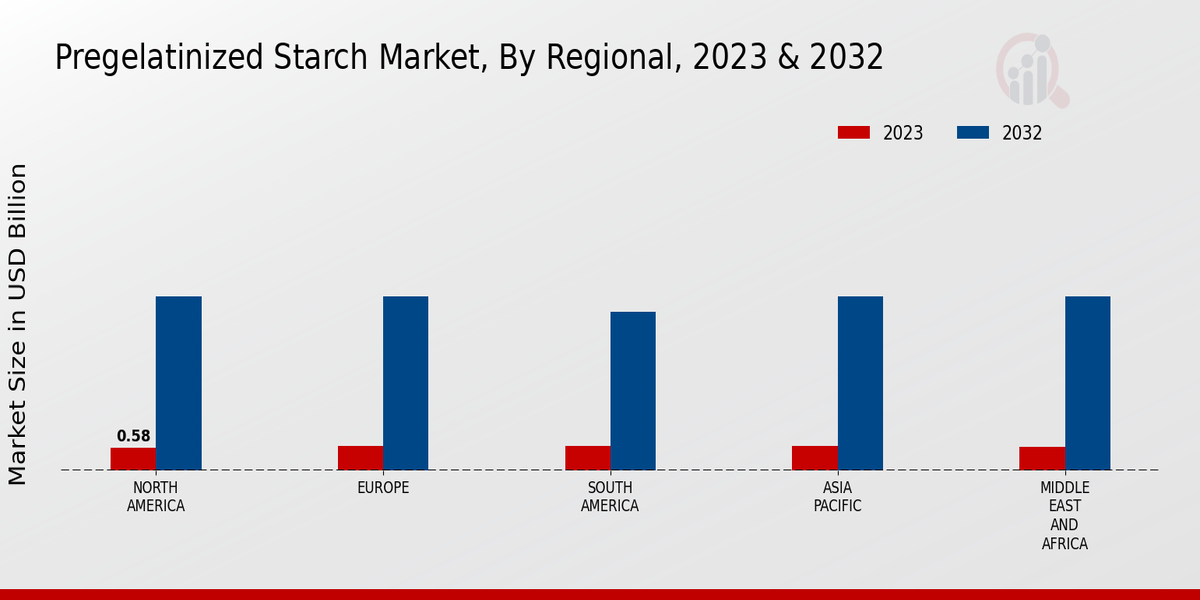Global Pregelatinized Starch Market Overview
Pregelatinized Starch Market Size was estimated at 2.95 (USD Billion) in 2022. The Pregelatinized Starch Industry is expected to grow from 3.08(USD Billion) in 2023 to 4.5 (USD Billion) by 2032. The Pregelatinized Starch Market CAGR (growth rate) is expected to be around 4.31% during the forecast period (2024 - 2032).

Source: Primary Research, Secondary Research, MRFR Database and Analyst Review
Key Pregelatinized Starch Market Trends Highlighted
Key market drivers for pregelatinized starch include the growing demand for convenient and easy-to-prepare foods, the increasing use of starch in various food applications, and the rising health consciousness among consumers. Opportunities in the market lie in the development of innovative starch-based products, the expansion of applications in emerging markets, and the growing demand for clean-label and sustainable ingredients.Recent trends in the pregelatinized starch market indicate a shift towards natural and organic ingredients, with consumers becoming more conscious about the origin and quality of their food. There is also a growing demand for starch-based products that offer specific functionalities, such as improved texture, stability, and nutritional value. Additionally, the development of new technologies is expected to drive growth in the market, enabling the production of customized starch products with tailored properties.
Pregelatinized Starch Market Drivers
-
Rising Demand for Convenience Foods
The demand for pregelatinized starch has been growing due to the increasing consumption of convenience foods, including ready-to-eat snacks, meals, and beverages. Such products remain stable for a longer period, which is achieved by the addition of pregelatinized starch as a hydrocolloid. What is more, pregelatinized starch does not require gelatinization, which is beneficial because of the high temperatures and agitating forces applied during processing.
Expansion of the Food and Beverage Industry
Another factor that is driving the Pregelatinized Starch Market Industry is the expanding food and beverage industry. The ever-increasing population, a substantial increase in disposable income and evolving tastes of people have given rise to the food and beverage industry. Pregelatinized starch is used in countless food and beverage products, such as bakery, confectionery, dairy, and sauces, among others. The starch offers improved texture, bite, and stability to these products, making them more likable.
Growing Health Consciousness
Consumers are more conscious of their health, thus gravitating to food products that are considered healthier and nutritious. Pregelatinized starch can be incorporated into such food products to lower their glycemic index, making them suitable for people with diabetes or those interested in controlling their blood sugar levels. Secondly, pregelatinized starch is a good source of dietary fiber that is essential for a healthy digestive system.
Pregelatinized Starch Market Segment Insights
Pregelatinized Starch Market Type Insights
It can be elucidated that there are several types of pregelatinized starch, such as modified starch, native starch, cross-linked starch, and thermally modified starch. Modified starch is the most common type of pregelatinized starch, which probably will account for around 50% of the global market share in 2024. The modified starch is chemically or enzymatically created from native starch. It is preferably used in the food industry as an effective thickening agent, which offers convenient processing to the manufacturers. Moreover, it can be employed as an oil-well quality control agent that works anywhere in the wellbore system.It also has multiple industrial applications, such as the production of concrete, cardboard, paper, textiles, and paints, as well as in fertilizers, seed coatings, and mineral processing. The native starch is the least modified pregelatinized starch, which does not undergo any processing after the extraction but dries and sifts. Moreover, the native starch retains the similar structure and properties of the starch grain. However, it can only be used in applications where the natural properties of the starch grain are required.
Accordingly, it is used in baby, sports, and diet meals, as well as gluten-free food.Cross-linked starch is the final form of pregelatinized starch, which is manufactured by mixing and drying cornstarch, sugar, salt, and seasonings. It is chemically cross-bonded to produce a more stable and resistant starch for heat, acid, and shear applications. It allows the formation of firm gels relative to the temperature as well as produces less gel with syneresis. It is normally used in pet food and oil drilling. The thermally modified starch is made by heating the starch grains to form immediate starch. It is applicable to the instant puddings, sauces, and gravy.

Source: Primary Research, Secondary Research, MRFR Database and Analyst Review
Pregelatinized Starch Market Application Insights
The Pregelatinized Starch Market is segmented based on application into Food and Beverages, Paper and Corrugated Board, Oil and Gas Exploration, Pharmaceuticals, and Textiles. Among these, the Food and Beverages segment held the largest market share in 2023 and is projected to continue its dominance throughout the forecast period. The increasing demand for processed and convenience foods is a key factor driving the growth of this segment. The Paper and Corrugated Board segment is expected to witness a significant growth rate during the forecast period.The increasing use of pregelatinized starch in paper and corrugated board manufacturing to improve strength, printability, and cost-effectiveness is fueling the growth of this segment.
The Oil and Gas Exploration segment is also projected to grow at a notable rate during the forecast period. Pregelatinized starch is used in oil and gas exploration to enhance the viscosity of drilling fluids, which helps in suspending and transporting cuttings. The Pharmaceuticals segment is another important application segment for pregelatinized starch. It is used as a binder, disintegrant, and filler in tablet and capsule formulations.The growing demand for pharmaceuticals is expected to drive the growth of this segment. The Textiles segment is also expected to contribute to the growth of the Pregelatinized Starch Market. Pregelatinized starch is used in textile manufacturing to improve fabric strength, drape, and appearance. The increasing demand for technical textiles is expected to drive the growth of this segment.
Pregelatinized Starch Market End-Use Industry Insights
The Pregelatinized Starch Market is segmented into various end-use industries, including Food Manufacturing, Beverage Production, Paper Production, Oil and Gas Exploration, and Pharmaceutical Manufacturing. The Food Manufacturing segment accounts for the largest share of the market, with a revenue of USD 1.2 billion in 2023. The Beverage Production segment is expected to grow at the highest CAGR of 5.5% during the forecast period 2023-2032. The Paper Production segment is also expected to witness significant growth, with a CAGR of 4.8% over the same period.The Oil and Gas Exploration and Pharmaceutical Manufacturing segments are expected to grow at a moderate pace during the forecast period. The Pregelatinized Starch Market is driven by the growing demand for processed foods, beverages, and paper products. The increasing use of pregelatinized starch in oil and gas exploration and pharmaceutical manufacturing is also contributing to the market growth.
Pregelatinized Starch Market Distribution Channel Insights
Distribution Channel Segment Overview The Pregelatinized Starch Market is segmented into Direct Sales, Distribution Through Agents and Distributors, and Online Sales. Among these, Direct Sales holds the largest market share, accounting for around 50% of the Pregelatinized Starch Market revenue in 2023. This is primarily due to the strong relationships and control that manufacturers have over their distribution channels, allowing them to optimize pricing and inventory management. Distribution Through Agents and Distributors is the second largest segment, with a market share of approximately 30%.This channel is preferred by manufacturers who do not have the resources or expertise to establish their own direct sales networks. Online Sales is the fastest-growing segment, with a projected CAGR of over 6% from 2023 to 2032. The growth of e-commerce and the increasing adoption of digital platforms are driving the demand for online sales of pregelatinized starch.
Pregelatinized Starch Market Regional Insights
The Pregelatinized Starch Market is segmented into North America, Europe, APAC, South America, and MEA. North America held the largest market share in 2023 and is expected to continue to dominate the market throughout the forecast period. The growth of the Pregelatinized Starch Market in North America is attributed to the increasing demand for convenience foods and the rising popularity of gluten-free products. Europe is the second-largest market for Pregelatinized Starch and is expected to witness significant growth in the coming years. The growth of the market in Europe is attributed to the increasing demand for Pregelatinized Starch in the food and beverage industry. APAC is the fastest-growing region for Pregelatinized Starch and is expected to continue to grow at a rapid pace in the coming years. The growth of the market in APAC is attributed to the increasing demand for Pregelatinized Starch in the food and beverage industry and the rising disposable income of consumers. South America and MEA are expected to witness moderate growth in the coming years. The growth of the market in these regions is attributed to the increasing demand for Pregelatinized Starch in the food and beverage industry and the rising population.

Source: Primary Research, Secondary Research, MRFR Database and Analyst Review
Pregelatinized Starch Market Key Players And Competitive Insights
Key players in the Pregelatinized Starch Market are focusing on offering new products that cater to changing customer expectations, expanding their product portfolio and strengthening their distribution outlets. A number of factors are impacting the viability of best-in-class products such as convenience as well as functionality. There is a trend of expanding base by leading companies that offer Pregelatinized Starch. Many players in the market are getting into collaborations to expand their presence in the market. To this end, they are able to combine their capabilities and knowledge to develop products and services that compete favorably in the marketplace. They are also able to reach a broader base of customers.One of the leading competitors in the Pregelatinized Starch Market is Cargill.
The Fortune 500 company has an annual revenue of over $110 billion. The company has various starches that are targeted towards various application areas. It also offers extensive customization by which products are tailored to fit the unique qualification requirements of customers. The corporation is heavily focused on research and development, and this is a key reason it is considered one of the leaders in the market. Not only has the company invested in a team of experts, but also they engage their customers extensively before settling on a solution.
The company’s clients are assured of best-in-class products that are of the highest quality. Ingredion Incorporated is another example of a leading market player in the Pregelatinized Starch Market. The firm is highly focused on research and development and is considered a leader in the market for the same reason. Using cutting-edge technologies and methodologies, the company is able to produce high-performance starches. The company’s products are highly competitive and innovative. The company has an extensive presence in more than 120 countries worldwide. The company has an interest in various sectors such as the household and personal care industries. Both companies have a strong presence globally but also focus on the regional markets.
Key Companies in the Pregelatinized Starch Market Include
- Pregelatinized Starch Market
- Ingredion Incorporated
- Cargill, Incorporated
- Archer Daniels Midland Company
- Avebe U.A.
- Agrana BeteiligungsAG
- Emsland Group
- The SAGO Group
- Sunstar Group
- Grain Processing Corporation
- Tate Lyle PLC
- Fujiwara Industry Co., Ltd.
Pregelatinized Starch Market Industry Developments
The Pregelatinized Starch Market size was valued at USD 3.08 billion in 2023 and is projected to reach USD 4.5 billion by 2032, exhibiting a CAGR of 4.31% during the forecast period. This growth can be attributed to the increasing demand for processed foods, convenience foods, and bakery products. Pregelatinized starch is used as a thickener, stabilizer, and binder in various food applications, and its ability to improve texture and stability makes it a preferred choice in food processing industries. The growing health consciousness among consumers has led to a shift towards natural and clean-label ingredients, which has positively impacted the demand for pregelatinized starch as it is derived from natural sources and is considered a safe and non-toxic ingredient.
Pregelatinized Starch Market Segmentation Insights
- Pregelatinized Starch Market Type Outlook
- Modified Starch
- Native Starch
- Cross-Linked Starch
- Thermally Modified Starch
- Pregelatinized Starch Market Application Outlook
- Food and Beverages
- Paper and Corrugated Board
- Oil and Gas Exploration
- Pharmaceuticals
- Textiles
- Pregelatinized Starch Market End-Use Industry Outlook
- Food Manufacturing
- Beverage Production
- Paper Production
- Oil and Gas Exploration
- Pharmaceutical Manufacturing
- Pregelatinized Starch Market Distribution Channel Outlook
- Direct Sales
- Distribution Through Agents and Distributors
- Online Sales
| Report Attribute/Metric |
Details |
| Market Size 2022 |
2.95 (USD Billion) |
| Market Size 2023 |
3.08 (USD Billion) |
| Market Size 2032 |
4.5 (USD Billion) |
| Compound Annual Growth Rate (CAGR) |
4.31% (2024 - 2032) |
| Report Coverage |
Revenue Forecast, Competitive Landscape, Growth Factors, and Trends |
| Base Year |
2023 |
| Market Forecast Period |
2024 - 2032 |
| Historical Data |
2019 - 2023 |
| Market Forecast Units |
USD Billion |
| Key Companies Profiled |
Pregelatinized Starch Market, Ingredion Incorporated, Cargill, Incorporated, Archer Daniels Midland Company, Avebe U.A., Agrana BeteiligungsAG, Emsland Group, The SAGO Group, Sunstar Group, Grain Processing Corporation, Tate Lyle PLC, Fujiwara Industry Co., Ltd. |
| Segments Covered |
Type, Application, End-Use Industry, Distribution Channel, Regional |
| Key Market Opportunities |
Rising demand in the food industry Expanding health food market Growth in pharmaceutical applications Increasing use of personal care products Potential in emerging markets |
| Key Market Dynamics |
1 Growing demand for convenience foods2 Rising awareness of health benefits3 Expansion of the food processing industry4 Technological advancements5 Increasing emphasis on clean-label products |
| Countries Covered |
North America, Europe, APAC, South America, MEA |
Frequently Asked Questions (FAQ) :
The Pregelatinized Starch Market is expected to reach USD 4.5 billion by 2032, exhibiting a CAGR of 4.31% during the forecast period (2024-2032).
The Asia-Pacific region is expected to hold the largest market share, owing to the increasing demand from food and beverage industries in countries such as China, India, and Japan.
Pregelatinized starch finds extensive application in the food and beverage industry, particularly in bakery and confectionery products, sauces, soups, and dairy products.
Major players in the Pregelatinized Starch Market include Ingredion Incorporated, Cargill, Incorporated, Archer Daniels Midland Company, Tate Lyle PLC, and Emsland Group.
The growing demand for convenience foods, the rising awareness of the health benefits of pregelatinized starch, and the increasing use of pregelatinized starch in various industrial applications are key factors driving market growth.
Fluctuating raw material prices, intense competition, and regulatory compliance can pose challenges to the growth of the Pregelatinized Starch Market.
The increasing adoption of clean-label ingredients, the growing demand for gluten-free products, and the rising popularity of plant-based foods are key trends shaping the Pregelatinized Starch Market.
The Pregelatinized Starch Market is expected to grow steadily over the forecast period, driven by the increasing demand from various industries and the growing awareness of its functional benefits.
Expansion into emerging markets, the development of innovative pregelatinized starch products, and strategic partnerships can present opportunities for growth in the Pregelatinized Starch Market.
The Pregelatinized Starch Market can be segmented based on type (native and modified), application (food and beverage, pharmaceuticals, papermaking, and others), and region (North America, Europe, Asia-Pacific, Latin America, and Middle East Africa).

















